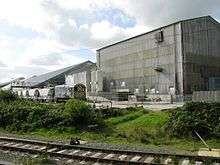China stone
China stone is a medium grained, feldspar-rich partially kaolinised granite characterized by the absence of iron-bearing minerals.[1][2] It is mainly used for making porcelain, hence the name, and coatings for paper.


Its discovery in the mid-18th century was a crucial event in the development of the English porcelain industry. The Quaker William Cookworthy (1705-1780) was probably the first to realize its significance, around 1745,[3] though his attempts at commercial exploitation, culminating in the founding of Plymouth porcelain in 1768, did not achieve long-term success. A letter of a Dr Richard Pococke from 1750 reports being shown near Lizard Point, Cornwall, a deposit "mostly valued for making porcelane ... and they get five pounds a ton for the manufacture of porcelane now carrying on at Bristol" (this Bristol enterprise being Lund's Bristol ware). However, this Lizard material was probably soapstone (steatite), which was very useful in reducing the tendency of soft-paste porcelain to shatter with rapid changes in temperature.[4] Existing English pottery companies, mostly from Staffordshire, swiftly moved to exploit the deposits.[5] For the first time English companies, led by Plymouth, were able make "true" hard-paste porcelain, rather than soft-paste porcelain, although the industry had already been experimenting with bone ash, and china stone soon became used in the highly successful English bone china instead.[6]
Its mineral content includes quartz, feldspar and mica; accessory minerals include kaolinite and fluorspar. It is found in one area of Cornwall in the United Kingdom, near St Austell,[7] and is the UK’s only indigenous source of feldspathic material commercially extracted. Production in the four years up to 2003 averaged 2,800 tonnes per year.[2]
Other names include Cornish or Cornwall stone.[8] It is sometimes confused with petuntse or "porcelain stone", which, although somewhat similar, is a different rock.
For most of the 20th century production was dominated by English China Clays Ltd/Plc, once a constituent of the FTSE 100 Index, but in 1999 acquired by the French company now called Imerys.
The St Austell and Clay Country Eco-town is a plan to build a new town on a cluster of sites owned by Imerys near St Austell. The plan was given outline government approval in July 2009. The plan would need to gain full planning permission before construction commenced.
See also
Notes
- Elkington, 14
- Cornwall County Council website, China clay and china stone undated, URL retrieved on 14 September 2007
- Honey, 82 note 1, 212, 332
- Honey, 4-5, 211 (and note 1)-216
- Elkington, 14
- Spero, 116-117; Honey, 4-5, 336-337
- Council PDF (96 pages) on current planning permissions etc
- "Archived copy". Archived from the original on 2007-09-28. Retrieved 2007-09-14.CS1 maint: archived copy as title (link) undated, URL retrieved on 14 September 2007
References
- Honey, W.B., Old English Porcelain: A Handbook for Collectors, 1977, 3rd edn. revised by Franklin A. Barrett, Faber and Faber, ISBN 0571049028
- Elkington, John, "Reclaiming the Cornish Moonscape", New Scientist, 5 Jan 1978, page 14
- Spero, Simon, Battie, David, ed., Sotheby's Concise Encyclopedia of Porcelain, 1990, Conran Octopus. ISBN 1850292515